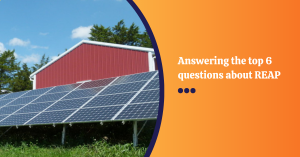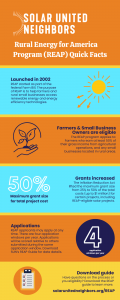
Rural Energy for America Program (REAP) Top 6 Questions
As part of its mission to help people go solar, national nonprofit Solar United Neighbors (SUN) released ‘Top 6 Questions’ on the USDA’s REAP
As part of its mission to help people go solar, the national nonprofit Solar United Neighbors (SUN) has released the ‘Top 6 Questions’ on the USDA’s Rural Energy for America Program (REAP).
“Whether you’re a small business owner or you own a farm, the Rural Energy for America Program (REAP) could be your key to unlocking the power of solar energy. Going solar is not just about saving money; it's about enhancing your operational goals, promoting energy independence, and boosting local economies,” said Anya Schoolman, Solar United Neighbors Executive Director.
REAP offers grants and loans to make solar more affordable. These grants are for up to 50% of the system cost and loans are available through a competitive application process. The Inflation Reduction Act quadrupled funding for the program. The USDA has also increased the number of application windows per year to four (quarterly) through 2024. This means there is more opportunity to secure funding to add solar to farms and rural businesses.
Here are the top six questions about REAP and how going solar can benefit your business:
1. How do I know if an applicant is eligible to apply?
Applicants need to meet specific criteria to be eligible for REAP. Generally, agricultural producers and rural small businesses in the United States are eligible. Some factors to consider to determine eligibility include:
Location: If a small business applicant, project must be in a rural area. Urban areas with populations exceeding 50,000 typically don't qualify. Check the USDA’s Rural Eligibility Map (https://eligibility.sc.egov.usda.gov/eligibility/welcomeAction.do?pageAction=rbs) to make sure the address is considered rural.
Small Business Size: Small business applicants must also meet the Small Business Administration's (SBA) size standards. That usually means having a tangible net worth of less than $15 million and an average net income of less than $5 million over the last two years.
Agricultural Operations: As an agricultural producer, applicants must earn at least 50% of gross income from agricultural operations. That includes crop production, livestock, forestry, and other similar activities. Agricultural producers can be located in rural or non-rural areas, and do not need to meet SBA size standards.
2. Can a REAP grant fund solar on a home?
REAP grants are intended for agricultural producers and rural small businesses. Because the program’s focus is on promoting renewable energy in the commercial and agricultural sectors, projects that would provide residential benefits are not eligible. However, applicants may explore other federal or state incentives for residential solar installations.
3. Can applicants use a REAP grant to install solar and battery storage?
Yes, a REAP grant can be sued to fund solar projects that include battery storage. This combination enhances an energy system's reliability and efficiency, making it an attractive option. Integrating battery storage allows users to store excess energy for use during periods of low solar generation or as backup power during outages. Charging stations for electric vehicles, when paired with a solar installation, are another option to get the most out of a new, renewable system.
4. When are applications due?
Applications can be submitted at any time. The USDA has increased the number of application windows to four times a year through 2024, creating more opportunities to get funding. For each window, applications should be submitted by 4:30 p.m. local time on the closing date. The USDA accepts applications throughout the year. The dates in 2024 are March 31, 2024, June 30, 2024, and September 30, 2024.
5. What happens after applying?
After submitting a REAP grant application, it will undergo a competitive review process. The USDA will evaluate applications based on various criteria. These include the project's viability, impact, and alignment with REAP goals. Applications will be scored on a 100-point scale. If an application is approved, funding to cover a portion of the costs of the solar project will be covered. Download SUN's Rural Business Guide (https://www.solarunitedneighbors.org/download-our-rural-business-guide/) for a detailed look at the process, and to estimate a score.
6. Can I still claim the federal solar investment tax credit if receive a REAP grant?
Yes, grant recipients can claim the federal solar investment tax credit alongside a REAP grant. The Federal Tax Credit is available to businesses installing solar energy equipment. It can be combined with other incentives, including REAP grants. This allows recipients to maximize savings and make the solar project more financially attractive. It is also advised to consult with a tax professional.
SUN has also put in place Ready, Set, Solar, REAP! (https://www.solarunitedneighbors.org/ready-set-solar-rural-businesses/), a free program designed to make the application process easier by offering step-by-step guidance over 10 weeks to complete and submit a USDA REAP grant.
As part of the program participants receive:
-A week of emails introducing the REAP grant process and a REAP guide, followed by an email a week with bite-size to-do’s for the remaining 9 weeks
-Unbiased, installer-neutral advice and expertise
-Support from a network of peers, including SUN staff and previous REAP grantees
Additional resources provided by SUN include:
An on-demand webinar ‘REAP Solar Grants & Your Rural Business’, in English and Spanish: https://www.youtube.com/watch?v=43ckopX_5M8
REAP guide in English https://www.solarunitedneighbors.org/download-our-rural-business-guide/ & Spanish https://www.solarunitedneighbors.org/descarga-nuestra-guia-de-negocios-rurales/
Solar Help Desk with hands-on support https://www.solarunitedneighbors.org/go-solar/want-to-install-solar/go-solar-on-your-own/
USDA website map to see if a rural business is in an eligible area (NOTE: qualifying farms are available regardless of location) https://eligibility.sc.egov.usda.gov/eligibility/welcomeAction.do?pageAction=rbs
USDA REAP FAQ (at the bottom of the page) https://www.rd.usda.gov/inflation-reduction-act/rural-energy-america-program-reap
# # #
Janelle Darst
Solar United Neighbors
+1 319-231-2435
jdarst@solarunitedneighbors.org
Visit us on social media:
Facebook
Twitter
LinkedIn
Instagram
YouTube
REAP Solar Grants & Your Rural Business
EIN Presswire does not exercise editorial control over third-party content provided, uploaded, published, or distributed by users of EIN Presswire. We are a distributor, not a publisher, of 3rd party content. Such content may contain the views, opinions, statements, offers, and other material of the respective users, suppliers, participants, or authors.




